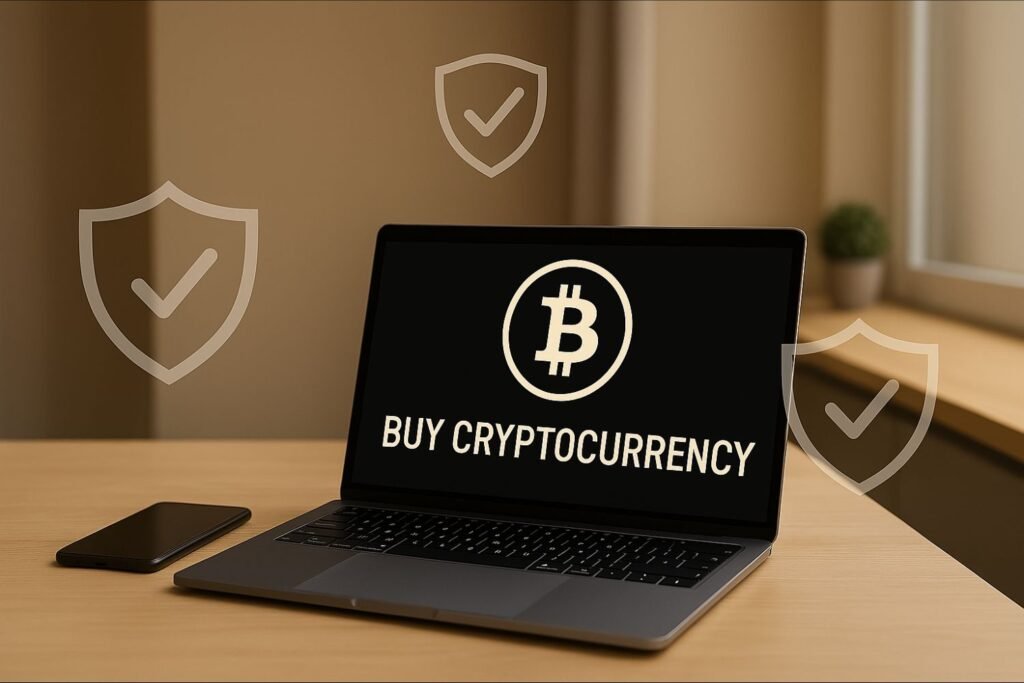⚠︎ Disclaimer: Cryptocurrency is a high-risk asset class. This content is for informational purposes only and does not constitute financial or investment advice. You may lose all of your capital. KoinGuide may earn a commission if you visit or sign up with a recommended provider via our affiliate links—at no additional cost to you. All recommendations are based on our independent reviews and evaluation process.
How to Buy Cryptocurrency Safely

Cryptocurrency is a revolutionary digital asset class, offering opportunities for investment and decentralized transactions. However, buying crypto safely demands knowledge to navigate potential pitfalls like scams, high fees, or lost funds. This guide provides a step-by-step roadmap for beginners to confidently purchase cryptocurrency, select reliable platforms, and secure their assets from the outset.
Step 1: Choose a Reputable Platform
It is importance to select a reputable one for a safe and cost-effective crypto purchase. Each type of platform caters to different needs, so consider your experience level, desired cryptocurrencies, and security preferences:
- Cryptocurrency Exchanges: These are digital marketplaces where users trade cryptocurrencies directly, with prices driven by supply and demand. Popular options include Coinbase (user-friendly, U.S.-based), Binance (global, extensive coin selection), and Kraken (strong security focus). Exchanges offer diverse trading pairs (e.g., BTC/USD, ETH/BTC), competitive fees (0.1–2%), and high liquidity, making them ideal for active traders or those seeking specific coins. However, they may have a steeper learning curve for beginners.
- Crypto Brokers: Platforms like eToro, Robinhood, or Cash App simplify the buying process with intuitive interfaces but often charge higher fees (2–5%) and support fewer cryptocurrencies. Brokers set their own prices, which may include a premium, making them less cost-efficient but excellent for beginners prioritizing ease of use.
- Peer-to-Peer (P2P) Marketplaces: Platforms like LocalBitcoins, Paxful, binance or Bisq allow direct trades between users, often using escrow services to secure transactions. P2P platforms typically have lower fees and support diverse payment methods (e.g., bank transfers, gift cards, mobile money (East Africa)), but they require caution to avoid untrustworthy traders. Always use platforms with strong escrow and dispute resolution systems.
How to Choose:
- Research platform reputation via user reviews on X Reddit, or trusted crypto sites like CoinDesk. Check for a history of security breaches or poor customer service.
- Verify regulatory compliance (e.g., registration with FinCEN in the U.S.) for added trust.
- Ensure the platform supports your desired cryptocurrencies and payment methods.
- Compare fees for trading, deposits, and withdrawals to optimize costs.
Step 2: Set Up and Secure Your Account
A secure account is your first line of defense against hacks and phishing. Follow these steps to create and protect your account:
- Sign Up: Register with your full name, email address, and a strong, unique password (at least 12 characters, mixing letters, numbers, and symbols). Use a password manager like LastPass or 1Password to generate and store it securely.
- Email Verification: Confirm your email via a link sent by the platform to activate your account.
- Complete KYC (Know Your Customer): Most platforms require identity verification to comply with anti-money laundering (AML) regulations. Upload a government-issued ID (e.g., passport, driver’s license) and proof of address (e.g., utility bill). Verification typically takes minutes to 24 hours, depending on the platform.
- Enable Two-Factor Authentication (2FA): Add an extra security layer by enabling 2FA, preferably through an authenticator app like Google Authenticator or Authy. Avoid SMS-based 2FA, as it’s vulnerable to SIM-swapping attacks.
- Bookmark the Official Website: Access the platform only through its official URL to avoid phishing sites. Never click links from unsolicited emails or messages.
Additional Security Measures:
- Use a dedicated email address for crypto accounts to limit exposure.
- Check the platform’s security features, like cold storage (offline asset storage) or insurance against hacks.
- Regularly monitor your account for unauthorized activity.
Tip: If a platform doesn’t require KYC or has weak security, it may be a red flag. Verify its legitimacy on trusted crypto forums.
Step 3: Fund Your Account
Before buying crypto, you need to deposit funds into your platform account. Options vary by platform and region:
- Fiat Currency Deposits:
- Bank Transfers: ACH or wire transfers are the most cost-effective (often free or under $1), but processing can take 1–5 business days.
- Credit/Debit Cards: Instant deposits but typically incur 2–5% fees. Check card compatibility and limits.
- Alternative Methods: Some platforms support PayPal, Venmo, or mobile money(Airtel,MTN),mobile payment apps (e.g., Zelle), but availability varies.
- Cryptocurrency Deposits: If you already own crypto, transfer it to the platform’s wallet address. Generate the address from your account dashboard, then send funds from your existing wallet (e.g., MetaMask or a hardware wallet). Always double-check the address, as errors are irreversible.
- Stablecoin Deposits: Platforms increasingly accept stablecoins like USDT or USDC, which are pegged to fiat currencies for stability.
Best Practical
- Start with a small test deposit (e.g., $10 or 0.001 BTC) to confirm the process works correctly.
- Verify deposit fees and minimums, as they vary by platform and method.
- For crypto transfers, ensure you’re using the correct blockchain network (e.g., Ethereum for ETH, Bitcoin for BTC) to avoid losing funds.
Tip: Save transaction records for tax purposes, as many countries require reporting crypto purchases.
Step 4: Purchase Cryptocurrency
With funds in your account, you’re ready to buy crypto. Select an order type based on your goals:
- Market Order: Buy instantly at the current market price. This is the fastest option, ideal for beginners, but prices may include a small spread (difference between buy and sell prices).
- Limit Order: Set a specific price at which you want to buy. The order executes only when the market reaches that price, potentially saving money but requiring patience.
- Recurring Buy: Platforms like Coinbase or Gemini allow scheduled purchases (e.g., $50 weekly), helping you dollar-cost average to reduce the impact of price volatility.
- Stop Order: Advanced users can set a price trigger to buy or sell automatically, useful for managing risk in volatile markets.
How to Buy:
- Select your cryptocurrency (e.g., Bitcoin, Ethereum, or smaller altcoins like Cardano).
- Enter the amount you want to purchase (in fiat or crypto units).
- Choose your order type and confirm the transaction.
- Review the total cost, including fees, before finalizing.
Tip: Start with a small investment ($50–$100) to familiarize yourself with the process and minimize risk. Research coins thoroughly, as many are highly speculative.
Step 5: Secure Your Cryptocurrency
Buying crypto is only the beginning; securing it is critical to protect against hacks, platform failures, or user errors:
- Avoid Storing on Exchanges: Exchanges are convenient but vulnerable to hacks, bankruptcy, or account freezes. Move your crypto to a personal wallet for long-term storage.
- Choose the Right Wallet:
- Software Wallets: Mobile or desktop apps like MetaMask, Trust Wallet, or Exodus are free and easy to use but stay connected to the internet, making them less secure for large amounts.
- Hardware Wallets: Devices like Ledger Nano X or Trezor Model T store private keys offline, offering the highest security. Ideal for holdings over $1,000. Expect to pay $50–$150 for a device.
- Paper Wallets: A low-tech option where you print your private and public keys. Secure but risky if lost or mishandled.
- Backup Your Wallet: Every wallet provides a 12–24 word recovery (seed) phrase. Write it down on paper, store it in a secure location (e.g., a safe or safety deposit box), and never store it digitally or share it.
- Test Transfers: Before moving large amounts, send a small test transaction to confirm the wallet address and process.
- Enable Multi-Layer Security: Use strong passwords, 2FA on all related accounts, and a reputable antivirus on devices accessing your crypto.
Tip: Split large holdings across multiple wallets (e.g., one hardware, one software) to diversify risk.
Safety Tips
- Beware of Scams: Never share private keys, seed phrases, or sensitive info. Avoid “too good to be true” offers, fake giveaways, or unsolicited messages promising profits.
- Verify Platforms and Apps: Only download apps from official stores (e.g., Google Play, Apple App Store) and access platforms via bookmarked URLs. Check X for reports of phishing or fraudulent sites.
- Understand Fees: Compare trading (0.1–5%), deposit, and withdrawal fees across platforms. Some charge network fees for crypto transfers, which vary by blockchain congestion.
- Stay Informed: Follow reputable sources like CoinDesk, CoinTelegraph, or verified X accounts (e.g., crypto analysts or exchanges) for market updates and security tips.
- Tax Compliance: Crypto purchases and sales may be taxable. Keep detailed records and consult a tax professional if needed.
- Diversify Investments: Avoid putting all funds into one cryptocurrency to reduce risk. Start with established coins like Bitcoin or Ethereum.


